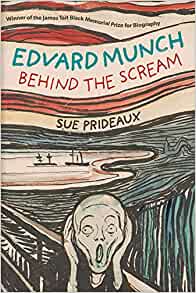Edvard Munch: Behind the Scream
Full Title: Edvard Munch: Behind the Scream
Author / Editor: Sue Prideaux
Publisher: Yale University Press, 2005
Review © Metapsychology Vol. 25, No. 8
Reviewer: Finn Janning
Who was the man behind The Scream, the iconic painting that expresses the anguish of the twentieth century?
Sue Prideaux raises this question in her biography Edward Munch: Behind the Scream about the Norwegian painter Edward Munch (1863–1944). The biography is not only the story of the painter’s emergence, but also a description of the intellectual climate in Oslo during his time. Prideaux succeeds in establishing an intimate relationship between the reader and its subject: Munch. We—the readers—get to know him.
A few times, she quotes Munch as saying, “Just as Leonardo da Vinci studied human anatomy and dissected corpses, so I was trying to dissect souls.” Although Munch mentions da Vinci, he was more inspired by the Russian writer Dostoevsky’s psychological knowledge. Perhaps for this reason, Munch also comes out as an existential painter who enlarges how we might experience the world. After all, he does not paint what he sees, but how he experience things.
Reading Prideaux’s writing about a famous Norwegian, I could not help but think about another one: the writer Karl Ove Knausgaard. In his novel The Struggle, he examines his own life, using fiction to create a space where he can explore his memories while telling them to himself or discussing them (and their validity) with others. Everything is of equal importance to Knausgaard—an argument with his wife is described with the same care as a brand of cereal. Some critics have seen Knausgaard’s project as either the renewal of the novel or a very long suicide note. Yet, what he kills is understood as a fixed self.
Similarly, Munch seems to literally kill the artist to make the painting vibrate with life—often the darker sides of life. The power of The Scream comes from its anonymity. It could represent all of us. A silent scream that we cannot block out.
Furthermore, the titles of Munch’s paintings are illustrative: Deathbed, Melancholy, Anxiety, The Scream, Death in the Sickroom, etc. Of course, the titles are one thing, but even more significant are the paintings themselves (and the book is full of illustrations). I found it remarkable how many of Munch’s paintings depict a person holding his or her hands up to his or her head. Incapable of finding peace in this world. Incapable of coping with what is happening. Incapable of holding on to his or her mind.
Munch was an extremely powerful and strong painter because of his fragility.
“I believe,” he wrote, “that each painting is an individual trying to achieve something on its own … My art, is self-confession. Through it, I seek to clarify my relationship to the world. This could be called egoism. However, I have always thought and felt that my art might be able to help others to clarify their own search for truth.”
Prideaux’s book helps me see this.
Finn Janning, PhD, is a writer and philosopher
Categories: ArtAndPhotography, Memoir
Keywords: Edward Munch, art

